Alfred Adrian Jones | |
|---|---|
 | |
| Born | 9 February 1845 Ludlow, Shropshire, England |
| Died | 24 January 1938 (aged 92) |
| Nationality | British |
| Alma mater | Royal Veterinary College |
| Known for | Sculpture |
| Notable work | Peace descending on the Quadriga of War |
Alfred Adrian Jones MVO (9 February 1845 – 24 January 1938) was an English sculptor and painter who specialized in depicting animals, particularly horses.[1] Before becoming a full-time artist he was an army veterinary surgeon for twenty-three years. On retirement from the Army, Jones established himself as an artist with a studio in London. He became a regular exhibitor at the Royal Academy and in commercial galleries from 1884 onwards. His training as a veterinary surgeon gave him a deep knowledge of equine anatomy which he used in his work to great effect. He created the sculpture Peace descending on the Quadriga of War, on top of the Wellington Arch at Hyde Park Corner in London. Following both the Boer War and World War I, Jones created a number of notable war memorials including the Royal Marines Memorial and the Cavalry of the Empire Memorial, both in central London. Alongside the public monuments he created, Jones made equestrian and equine statuettes and portrait busts.[2] Whilst well known as a sculptor, Jones was also an accomplished painter.
Biography
Early life and military career
Jones was born in Ludlow, Shropshire, the fourth son of James Brookholding Jones and his wife Jane Marshall, and was educated at Ludlow Grammar School.[3] Despite his wish for a career as an artist, Jones was persuaded by his father to train as a vet.[3] He studied at the Royal Veterinary College, qualifying as a veterinary surgeon in 1866.[3] He enrolled in the Army as a veterinary officer in the Royal Horse Artillery the following year and served from 1867 to 1890. During this time he saw service in the Abyssinian Expedition of 1868 before joining the 3rd Hussars in 1869.[3] From 1871 to 1881 he served with the Queen's Bays in Ireland and was then attached to the 7th Queen's Own Hussars and fought with them in the First Anglo-Boer War in 1881. In South Africa he was attached to the Inniskilling Dragoons. In 1884 Jones served in Egypt where he selected camels for the Nile Expedition and finally joined the 2nd Life Guards, retiring in 1890 with the rank of captain. [3] He was awarded a medal for his service in Abyssinia and the Khedive's Star for his work on the Nile Expedition.[4] Jones was made a member of the Royal Victorian Order in 1907.[4]
Artistic career
Jones was already active as an artist by the time he retired from the Army, having painted and sketched throughout his military career. In 1892 he had received some teaching in sculpture techniques from Charles Bell Birch and had shown a plaster statuette, One of the Right Sort, at the Royal Academy in 1884.[3][5] In 1887 Jones' bronze Gone Away won first prize in the Goldsmith's Company's statuette contest. His terracotta Camel Corps Scout and The Last Arrow in bronze were both well received when exhibited in 1886 and 1888 respectively.[3] Jones became a regular exhibitor at the Royal Academy, at the Royal Glasgow Institute of the Fine Arts and in commercial galleries plus at the Paris Salon and the Royal Institute.[1][4][2]
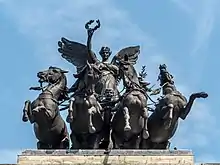
In 1891 Jones exhibited a plaster work, Triumph featuring a quadriga of four horses and a chariot.[6] The model greatly impressed the Prince of Wales who began campaigning for a monumental version to be created for the Wellington Arch in central London.[4][6] Opposition to this proposal was led by Sir Frederick Leighton, the president of the Royal Academy, who considered the commission beyond the ability of a largely self-taught artist such as Jones. To demonstrate his skill with large scale works, Jones created Duncan's Horses, a plaster equine group shown at the Royal Academy in 1892.[3] Despite insinuations that Duncan's Horses was not by him, Jones won the Wellington Arch commission and worked on Peace descending on the Quadriga of War from 1907 until 1912. Until his death in 1910, Edward VII frequently visited Jones' studio to view progress on what became largest bronze sculpture in Britain.[3] The casting was completed by November 1911 and the complex matter of hoisting the Quadriga into position took place in January 1912. In April 1912 King George and Queen Mary drove through the arch and were presented to Jones. The addition of a tablet noting that the Quadriga was a gift of Lord Michelham was affixed to the monument in 1916. The young boy in Jones' composition for the Quadriga was based on Lord Michelham's son.[6]
Jones was also an accomplished painter. His notable paintings included a portrait of Lord Kitchener and an equestrian portrait of Sir David Campbell on his Grand National winning horse.[4]
Later life
Nominated by Goscombe John, Jones became a member of the Royal Society of British Sculptors in 1912 and was elected a Fellow of the same society in 1923.[1] Jones' autobiography, Memoirs of a Soldier Artist was published in 1933.[7] In 1934 Jones became an Honorary Associate of the Royal College of Veterinary Surgeons, and he was also an honorary member of the Incorporated Association of Architects and Surveyors.[4] In 1935 he received the gold medal of the Royal Society of British Sculptors.[4]
Jones was married twice. In 1870 he married Emma Buckingham from Ross-on-Wye who died in 1887 and in 1891 he married Emma Wedlake and established a home and studio with her in Chelsea.[3] That property was next door to the Chelsea Arts Club and Jones became an active member and sometimes office holder of the club.[3] He died of influenza and bronchitis at his home in 147 Church Street, Chelsea, in January 1938 aged 92 and was cremated at Golders Green Crematorium. A memorial plaque to Jones is to be found at St. Laurence's Church in Ludlow, where his ashes are buried, next to that of the poet A. E. Housman.[8][9]
Selected public works
1895–1919
| Image | Title / subject | Location and coordinates |
Date | Type | Material | Dimensions | Designation | Wikidata | Notes |
|---|---|---|---|---|---|---|---|---|---|
 |
Persimmon | Sandringham Stud, Norfolk | 1895 | Equine statue on plinth | Bronze & stone | [3][10][4] | |||
| South Australian Boer War Contingents | Ludlow College, Ludlow | Model of horse's head | Plaster | Originally positioned by Ludlow Town Hall, relocated 1988 to National Army Museum, London. Originally a plaster cast of a mounted cavalry man but only the horse's head remains.[11] | |||||
 More images |
Royal Marines Memorial | The Mall, London | 1903 | Sculpture group on pedestal with plaques | Bronze & Portland stone | Grade II | Q18121475 | [12][13][14][15] | |
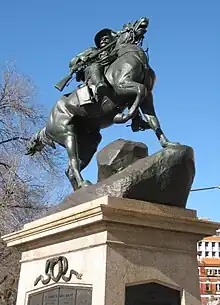 More images |
South African War Memorial (South Australia) | Government House, Adelaide, Australia | 1904 | Equestrian statue on pedestal | Bronze & stone | Q7565810 | [16] | ||
 More images |
Statue of Redvers Buller | Exeter, Devon | 1905 | Equestrian statue on pedestal | Bronze & granite | Grade II | Q26558036 | [10][17][18] | |
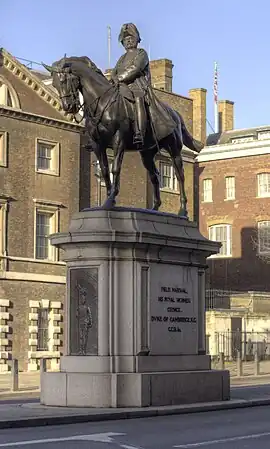 More images |
Statue of Prince George, Duke of Cambridge | Whitehall, London | 1907 | Equestrian statue on pedestal | Bronze & granite | 7.6m tall | Grade II | Q19516037 | Cast by A.B. Burton, Thames Ditton Foundry, pedestal by John Belcher[19][20][21] |
.jpg.webp) More images |
Carabiniers Boer War memorial | Ranelagh Gardens, Chelsea Embankment, London | 1906 | Three sided screen with reliefs | Brick, stone & bronze | Q63647854 | [22][23] | ||
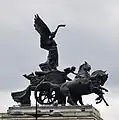 More images |
Peace descending on the Quadriga of War | Wellington Arch, Hyde Park Corner, London | 1912 | Sculpture group | Bronze | Grade I | Cast by A.B. Burton at the Thames Ditton Foundry.[10][19][24] |
1920-1929
| Image | Title / subject | Location and coordinates |
Date | Type | Material | Dimensions | Designation | Wikidata | Notes |
|---|---|---|---|---|---|---|---|---|---|
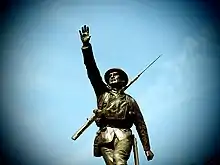 More images |
Bridgnorth War memorial | Castle Gardens, Bridgnorth, Shropshire | 1922 | Statue on pedestal | Bronze & stone | Grade II | Q26539222 | Statue depicts a King's Shropshire Light Infantry soldier[12][25][26][27] | |
 More images |
Royal Gloucestershire Hussars Memorial | College Green, Gloucester | 1922 | Cross on stepped plinth with bas-reliefs | Stone & bronze | Grade II* | Q26263469 | Four relief panels depicting scenes from Gallipoli, Syria, Sinai and Palestine by Jones, additional panel by Edward Payne, stone work by Cash & Wright[28][29][30] | |
 More images |
Cavalry of the Empire Memorial | Hyde Park, London | 1924 | Equestrian statue on pedestal with surround | Bronze & stone | Grade II* | Q20794956 | Architect, John James Burnet[12][31][32][33] | |
 More images |
Uxbridge War memorial | Windsor Circus, Uxbridge, London | 1924 | Statue on column | Bronze & granite | Grade II | Q28147646 | [12][7][34] | |
 |
Lieutenant-Colonel Charles Berkeley Pigott, CB, DSO, late of 60th Rifles and 21st Lancers | North Aisle, Winchester Cathedral, Hampshire | Memorial plaque | [35] |
Other works
- For the Faith, a 1903 equestrian statuette, current whereabouts unknown, shown at the Royal Academy in 1903.[36]
- A silver statuette of Colonel Asfur Dowla, the A.D.C. to the Nizam of Hyderabad, shown at the Royal Academy in 1903, but current whereabouts unknown.[5][37]
- In 1985, Jones' 1892 plaster group Duncan's Horses was cast in bronze and erected in the grounds of the Royal Veterinary College, Hawkshead Campus in Hertfordshire.[3]
Gallery of images
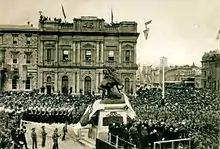 The unveiling of the Boer War Memorial in Adelaide
The unveiling of the Boer War Memorial in Adelaide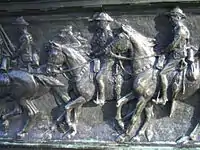 Relief on Cavalry Memorial
Relief on Cavalry Memorial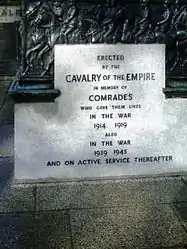 Plaque on Cavalry Memorial
Plaque on Cavalry Memorial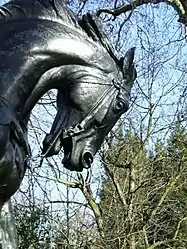 Head of Horse-Cavalry Memorial
Head of Horse-Cavalry Memorial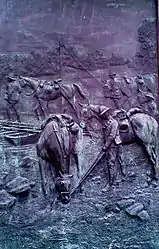 Relief on Gloucester Memorial
Relief on Gloucester Memorial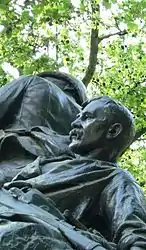 Wounded Marine on Royal National Marine Memorial
Wounded Marine on Royal National Marine Memorial
Further reading
- "Memoirs of a Soldier Artist" by Adrian Jones, published by Stanley Paul & Co. London. 1933
- "Triumph: The Life and Art of Captain Adrian Jones" by Robert S. Burns, published by Logaston Press www.logastonpress.co.uk ISBN 978 1 906663 44 5.
- "Adrian Jones: Cavalry Officer, Veterinary Surgeon and distinguished Sculptor/Artist", article published by Veterinary History (pages 68–72)~ Journal of the Veterinary History Society, Vol 15 No.1, 2009. ISSN 0301-6943.
References
- 1 2 3 University of Glasgow History of Art / HATII (2011). "Captain (Alfred) Adrian Jones". Mapping the Practice and Profession of Sculpture in Britain & Ireland 1851–1951. Retrieved 5 May 2022.
- 1 2 James Mackay (1977). The Dictionary of Western Sculptors in Bronze. Antique Collectors' Club. ISBN 0902028553.
- 1 2 3 4 5 6 7 8 9 10 11 12 13 Sarah Crellin (23 September 2004). "Jones, Adrian (1845-1938), sculptor". Oxford Dictionary of National Biography (online ed.). Oxford University Press. doi:10.1093/ref:odnb/34220. ISBN 978-0-19-861412-8. Retrieved 6 May 2022. (Subscription or UK public library membership required.)
- 1 2 3 4 5 6 7 8 "Obituary. Captain Adrian Jones Horses in Sculpture", The Times, 25 January 1938
- 1 2 Algernon Graves (1905). The Royal Academy: A Complete Dictionary of Contributors from its Foundations in 1769 to 1904. Vol. 4. London: Henry Graves. p. 261.
- 1 2 3 Steven Brindle. "History of Wellington Arch". English Heritage. Retrieved 6 May 2022.
- 1 2 Historic England. "Uxbridge War Memorial (1464803)". National Heritage List for England. Retrieved 5 May 2022.
- ↑ Memorial Plaque in Ludlow Ludlow Guide. Retrieved 17 November 2012.
- ↑ Shropshire War Memorials, Sites of Remembrance, p.61.
- 1 2 3 Jo Darke (1991). The Monument Guide to England and Wales. Macdonald Illustrated. ISBN 0-356-17609-6.
- ↑ "War Memorials Register: South Australian Contingents". Imperial War Museum. Retrieved 5 May 2022.
- 1 2 3 4 Alan Borg (1991). War memorials: From Antiquity to the Present. Leo Cooper. ISBN 085052363X.
- ↑ "War Memorials Register: Royal Marine National Memorial". Imperial War Museum. Retrieved 4 May 2022.
- ↑ Historic England. "The Royal Marines Memorial (1239070)". National Heritage List for England. Retrieved 4 May 2022.
- ↑ "Royal Marines Memorial". The Courtauld Institute of Art. Retrieved 15 December 2022.
- ↑ South African War Memorial Professional Historians Association (South Australia). Retrieved 16 November 2012.
- ↑ Buller Statue Archived 13 September 2011 at the Wayback Machine Exeter Memories. Retrieved 16 November 2012.
- ↑ Historic England. "Equestrian statue of General Redvers Buller, at junction of Hale Road (1267653)". National Heritage List for England. Retrieved 4 May 2022.
- 1 2 Arthur Brian Burton (1860–1933) – British bronze sculpture founders and plaster figure makers, 1800–1980, National Portrait Gallery, London
- ↑ The Statue of Prince George Victorian Web. Retrieved 16 November 2012.
- ↑ Historic England. "Statue of the Duke of Cambridge (1066108)". National Heritage List for England. Retrieved 4 May 2022.
- ↑ History of The Carabiniers Archived 10 August 2016 at the Wayback Machine National Army Museum. Retrieved 15 November 2012.
- ↑ "War Memorials Register: 6th Dragoon Guards (the Carabiniers)". Imperial War Museum. Retrieved 4 May 2022.
- ↑ Historic England. "Wellington Arch (1278092)". National Heritage List for England. Retrieved 5 May 2022.
- ↑ Peter Francis (2013). Shropshire War Memorials, Sites of Remembrance. YouCaxton Publications. pp. 108–109. ISBN 978-1-909644-11-3.
- ↑ "War Memorials Register: Bridgnorth". Imperial War Museum. Retrieved 5 May 2022.
- ↑ Historic England. "War Memorial, Castle Grounds (1246857)". National Heritage List for England. Retrieved 5 May 2022.
- ↑ "War Memorials Register: Royal Gloucestershire Hussars". Imperial War Museum. Retrieved 5 May 2022.
- ↑ Historic England. "War Memorial to the Royal Gloucestershire Hussars Yeomanry (1245906)". National Heritage List for England. Retrieved 5 May 2022.
- ↑ "Yeomanry War Memorial". The Courtauld Institute of Art. Retrieved 15 December 2022.
- ↑ "War Memorials Register: Cavalry of the Empire". Imperial War Museum. Retrieved 5 May 2022.
- ↑ Historic England. "The Calvary Memorial (1278118)". National Heritage List for England. Retrieved 5 May 2022.
- ↑ "Monument to the Cavalry of the Empire". The Courtauld Institute of Art. Retrieved 15 December 2022.
- ↑ "War Memorials Register: Uxbridge WW1 And WW2 Figure". Imperial War Museum. Retrieved 5 May 2022.
- ↑ Plaque to Charles Berkeley Pigott Victorian Web. Retrieved 16 November 2012.
- ↑ For the Faith Victorian Web. Retrieved 16 November 2012.
- ↑ Colonel Asfur Dowla Victorian Web. Retrieved 16 November 2012.
External links
- 24 artworks by or after Adrian Jones at the Art UK site